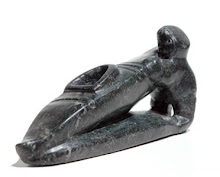
It's hardly news that paddle extension is pretty much integral to Greenland-style paddling. To such a point, in fact, that it has been argued that one of the marks of a true Greenland paddle is that its owner should be able to securely and comfortably grip it anywhere along its length. And the extended paddle it's not just for rolls and braces. Rudder and forward propulsion strokes (e.g., the sliding stroke) take advantage of the possibilities it offers as well.

Aleutian paddles differ from Greenland ones in, among other things, being assymmetric, but they superficially resemble them as they also have long, thin blades and relatively short looms. Thus, Aleutian kayakers captured with extended paddles in old photographs may not be much of a surprise either. Most such pictures I've seen show the extensions being for braces to stabilize two- or three-seat craft. Most, but not all, as, at least to my eyes, the paddler in the picture just below does not seem to be bracing .

Unfortunately, our knowledge of Aleutian paddling practices is sorely lacking in many areas (we are not even sure if they rolled their boats, remember?) and I have not come across anything about the spread, functions etc... of paddle extension in this kayaking tradition (I'd greatly appreciate any pointers, by the way). We just seem to have little more than a few images that are difficult to understand adequately.

That is also the case, even to a greater extent, for other native Arctic kayakers. Old pictures show that, at least occasionally, they held their paddles by their blades. Even though those blades were wider than Greenlandic or Aleut ones, as in the case of paddlers from the Noatak area in North Alaska (look at paddlers on the left in the picture above) or from the Mackenzie Delta (below).

Their with would suggest that, unlike Greenland paddles, full paddle extension was not a design requirement for North Alaska or Mackenzie Delta blades. It seems safe to hypothesize they did not routinely use a full sliding stroke in those areas, but detailed questions would probably require the kind of information that only a live kayaking tradition can provide. We are lucky that kayaking remained alive (if barely) in Greenland, but from what we have learned from there we can perhaps begin to guess what we might have missed from the extinction of traditional kayaking almost everywhere else.


